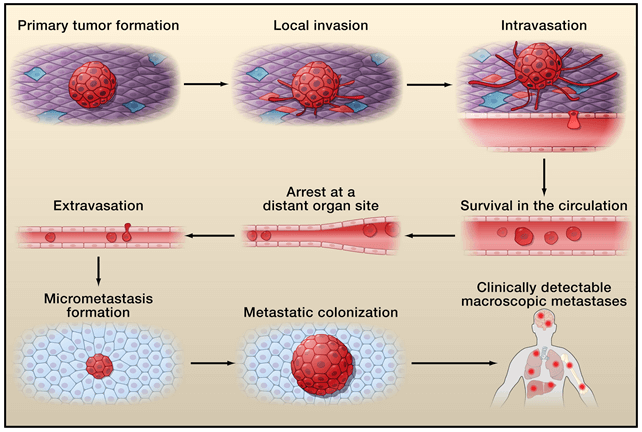Creative Bioarray provides customized solutions based on different cell invasion assays according to different requirements to accelerate your fundamental research and drug development projects.
Introduction of Cell Invasion
Cell invasion is a phenotypic characteristic related to cell migration. The difference is that cell invasion defines the ability of cells to migrate within a tissue or infiltrate into neighbouring tissues through the extracellular matrix, which is degraded by protease in the process of invaison.
Cell invasion is involved in pathological processes of many diseases. For cancer, tumor cell invasion is one of the hallmarks of the metastatic phenotype. The ability of tumor cells to degrade the ECM proteins of the basement membrane surrounding the blood vessel endothelium is directly correlated with metastatic potential of cancer. The invasiveness of malignant tumor cells greatly affects the morbidity and mortality of cancers, and determines the clinical prognosis of the patients.
With the development of cell invasion assays, quantitative and in-depth study of cell invasion is more and more helpful to reveal the molecular processes of related diseases, so as to find new potential therapeutic methods and assess their effectiveness.
 Figure 1. The invasion–metastasis cascade. (Faltas B, 2012)
Figure 1. The invasion–metastasis cascade. (Faltas B, 2012)
Cell Invasion Assays Available at Creative Bioarray
For different research purposes, we provide customized solutions based on but not limited to the following assays:
Transwell Cell Invasion Assays
Transwell inserts are the modification of Boyden chambers. They contain cell-permeable membrane, which are covered with a thin gel layer to mimic the extracellular matrix encountered by tumor cells during the invasion process in vivo. Transwells permit accurate repeatable invasion assays.
This assay is widely used to study cell invasion and the metastatic potential of tumor cells. It is also possible to evaluate the effect of chemoattractants or inhibiting compounds on cell invasion. Our experienced scientific team can choose the Transwell inserts with the most suitable pore diameter according to the specific needs.
Gelatin Degradation Assay
Gelatinase A (MMP-2) and Gelatinase B (MMP-9) are two mammalian gelatinases that play a critical role in the degradation of basement membrane. They are reported to be highly upregulated in various tumor cells. Gelatin degradation assay is to culture cells on a florescent gelatin substrate. The cleavage of gelatin by gelatinase results in the release of fluorescence group, which can be easily quantified by microplate reader.
This assay has the advantages of substrate-specificity, fast, simple operation, and high-throughput adaptable. It allows the visualization and quantification of cell invasion at the subcellular level with high resolution.
Spheroid Invasion Assay
Spheroid invasion assay is based on uniform, self-assembling three-dimensional tumor spheroids. It is a simple, highly reproducible and standardized method, which can provide a rapid and automatic invasion system to determine the process of cell invasion. This method is helpful to further understand the mechanism of cancer metastasis.
Creative Bioarray can provide customized services in a timely and cost-effective manner. We have built our reputation by providing high-quality results. If you need more detailed information, please feel free to contact us. We look forward to cooperating with you.
References:
- Faltas B. Cornering metastases: therapeutic targeting of circulating tumor cells and stem cells. Frontiers in oncology, 2012, 2: 68.
- Eccles S A, et al. Cell migration/invasion assays and their application in cancer drug discovery. Biotechnology annual review, 2005, 11, pp: 391-421.
- Bravo-Cordero J J, et al. Directed cell invasion and migration during metastasis. Current opinion in cell biology, 2012, 24(2), pp: 277-283.
For research use only. Not for any other purpose.

 Figure 1. The invasion–metastasis cascade. (Faltas B, 2012)
Figure 1. The invasion–metastasis cascade. (Faltas B, 2012)
